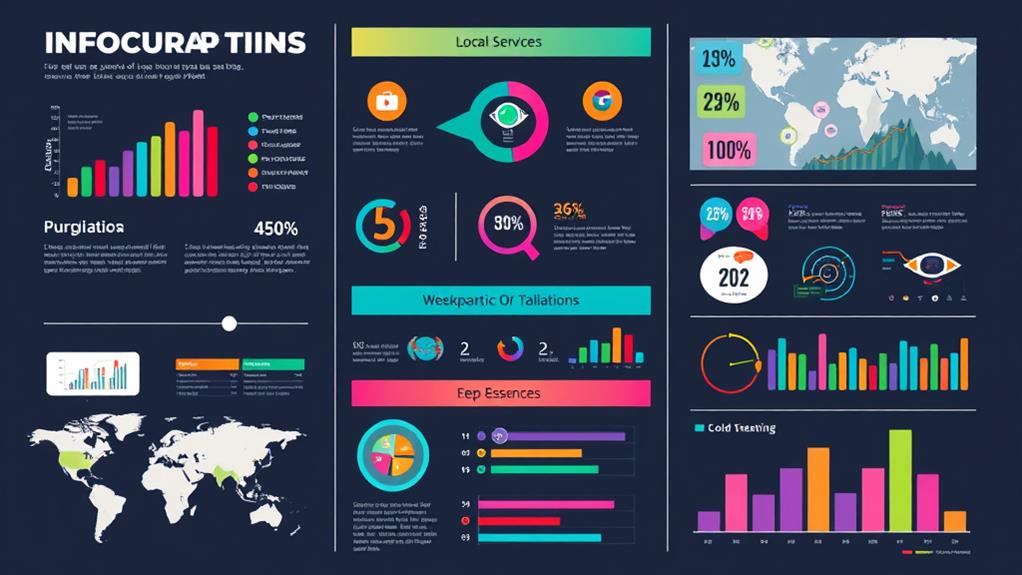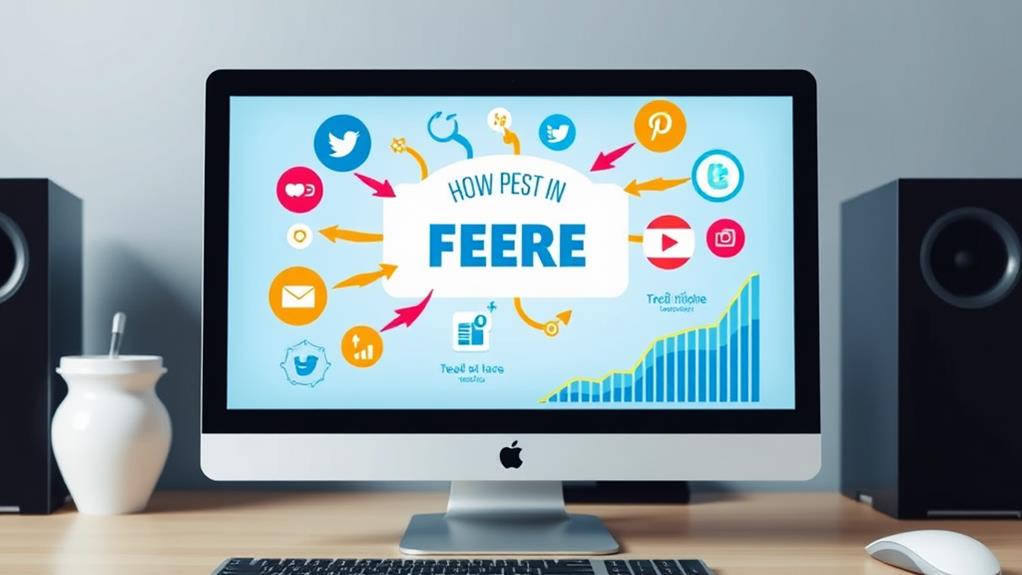Designing social media infographics that drive traffic requires a blend of compelling design principles and strategic content planning. Start by selecting engaging, trending topics through tools like Google Trends, addressing specific audience pain points. Effective keyword research using platforms like Ahrefs and Google's Keyword Planner enhances visibility. Use a limited color palette and a minimalist design to maintain clarity. Incorporate actionable solutions and relatable visuals to foster engagement. Promotional strategies, such as influencer collaborations and targeted social media campaigns, amplify reach. Tracking performance through analytics and feedback aids in refining techniques. Discover advanced strategies to maximize impact.
Key Takeaways
- Utilize trending topics and user pain points to create relevant and engaging infographics.
- Incorporate branding elements and a consistent color palette to enhance brand recognition and visual appeal.
- Leverage keyword research tools to identify and integrate long-tail keywords for improved SEO and targeted traffic.
- Break infographics into smaller sections and use niche-specific hashtags to boost social media engagement.
- Embed social sharing buttons and collaborate with influencers to amplify reach and encourage sharing.
Importance of Infographics
In the domain of digital marketing, the importance of infographics cannot be overstated. As the human brain processes visual data 60,000 times faster than text, infographics serve as a potent means of visual storytelling, enabling marketers to convey complex information swiftly and effectively. This rapid processing capability markedly boosts audience engagement, making infographics indispensable in content marketing strategies.
Moreover, using data-driven goal setting guarantees that the infographics align with broader marketing objectives, enhancing their effectiveness.
In 2019, 40% of marketers identified infographics as their best-performing content type, underlining their critical role in enhancing brand visibility. Studies corroborate this, showing that 84% of respondents find infographics effective, a confirmation of their broad appeal and efficacy.
Not only do infographics captivate audiences, but they also generate substantial website traffic by being highly shareable on social media platforms, hence creating numerous backlinks that enhance search engine rankings.
Additionally, incorporating branding elements within infographics fosters brand recognition, increasing visibility and link potential across various platforms. The compelling nature of visual storytelling through infographics consequently guarantees that audiences remain engaged, making them an essential tool for any marketer aiming to maximize their digital presence and drive traffic.
Selecting Engaging Topics
In creating engaging social media infographics, leveraging trending topics identified through tools like Google Trends guarantees your content remains current and captures audience interest.
Addressing specific customer pain points by providing solutions or answering common questions enhances the value and shareability of your infographics.
For instance, incorporating visual content that drives higher engagement can make your infographics more appealing.
Addressing User Pain Points
Identifying and addressing user pain points is essential for creating engaging infographics that resonate with your target audience. By focusing on common challenges or questions, your infographics become more relevant and appealing. Research indicates that content addressing specific customer pain points tends to drive higher engagement rates, as audiences are more inclined to share solutions that genuinely resonate with their needs.
To effectively tackle user pain points, consider the following strategies:
- User Feedback: Collect direct feedback from your audience to identify recurring issues and questions. This data-driven approach guarantees that your content is relevant and impactful.
- Content Empathy and Visual Storytelling: Use empathetic content and compelling visuals to create a narrative that speaks directly to your audience's challenges.
- Solution Focus: Provide actionable solutions within your infographics. Practical tips and expert advice can enhance credibility and audience engagement.
- Myth Busting Strategies: Address and debunk common misconceptions related to your audience's pain points. This not only attracts interest but also encourages sharing, thereby increasing visibility and traffic.
Incorporating relatable examples and expert quotes can further augment the effectiveness of your infographics, making them a valuable resource for users seeking solutions to their challenges.
Leveraging Trending Topics
Leveraging trending topics can greatly amplify the impact of your social media infographics, ensuring they capture and maintain audience attention. Utilizing trending tools like Google Trends is essential for identifying subjects that resonate with your audience. By tapping into these data-driven insights, you can enhance the relevance of your content, making it more likely to drive traffic.
Infographics that focus on evergreen subjects consistently engage audiences, offering sustained traffic long after their initial publication. However, incorporating trending topics can provide a notable boost in immediate engagement. To achieve this, research popular content on platforms like YouTube to uncover what is currently enchanting audiences. These audience insights can inspire the creation of infographics that are both timely and compelling.
Controversial topics, while risky, can provoke discussion and sharing, making them effective for generating buzz. Titles that evoke curiosity or debate about trending subjects can considerably increase viewer interest, leading to higher engagement rates.
Combining the timeless appeal of evergreen content with the immediate relevance of trending topics creates a powerful strategy for designing infographics that drive traffic and foster ongoing audience interaction.
Keyword Research Strategies
To enhance the reach and impact of your social media infographics, leveraging tools such as Google's Keyword Planner and Ahrefs is essential for identifying high-performing keywords.
Prioritizing long-tail keywords can greatly boost your ranking potential due to their specificity and lower competition.
Additionally, effective keyword placement in titles and meta descriptions is important for optimizing search results.
Monitoring keyword performance with tools like Linkio and using Google's autocomplete feature to inform your keyword strategy will guarantee your content remains optimized and relevant.
Effective Keyword Tools
Crafting compelling social media infographics requires a robust keyword research strategy to confirm maximum visibility and engagement. A pivotal component of this strategy is utilizing effective keyword tools.
Begin with Google's Keyword Planner, which allows for thorough keyword analysis tailored to your target audience's interests. This tool helps identify relevant keywords that can enhance your infographic's search engine visibility.
Essential Keyword Tools for Infographic Success:
- Google's Keyword Planner: Ideal for conducting in-depth keyword analysis, this tool aids in discovering keywords that resonate with your audience.
- Competitor Research: Analyze your competitors' keyword strategies to uncover gaps and opportunities. Tools like SEMrush can provide insights into the high-performing keywords in your niche.
- Google Autocomplete: Leverage this feature to find related search queries, enhancing the relevance of your infographics.
- Linkio: Regularly monitor your keyword rankings with Linkio to evaluate the effectiveness of your strategy and make necessary adjustments.
Incorporating these tools into your strategy not only refines your keyword selection but also verifies your content remains trend-aware and audience-focused.
Additionally, integrating target keywords into social media captions and descriptions, along with relevant hashtags, can greatly boost reach and engagement.
Long-Tail Keywords Benefits
While effective keyword tools lay the groundwork for a solid keyword strategy, focusing on long-tail keywords can further refine your approach. Long-tail keywords, which typically experience lower competition, enhance your chances of ranking higher in search engine results, thereby driving more targeted traffic to your infographics.
Research indicates that long-tail keywords account for approximately 70% of all search queries, underscoring their vital role in attracting a niche audience.
Incorporating long-tail keywords into your keyword targeting strategies is essential for niche audience engagement. Tools like Google's Keyword Planner can be instrumental in identifying these valuable keywords that align with your content and audience interests.
By integrating long-tail keywords into infographic titles, descriptions, and alt text, you greatly bolster your SEO efforts, improving visibility and engagement on social media platforms.
Moreover, long-tail keywords enable marketers to create more specific and relevant content that addresses customer pain points directly. This specificity not only enhances user experience but also leads to higher conversion rates.
Optimizing Search Queries
Releasing the full potential of your social media infographics begins with enhancing search queries through robust keyword research strategies. Utilizing tools like Google's Keyword Planner and Ahrefs can help identify high-performing keywords related to your infographic topic.
Prioritize keywords with significant search volume and lower competition to improve visibility. Long-tail keywords are essential as they are typically more specific and easier to rank for, thereby attracting a more targeted audience. These keywords enhance query optimization by aligning closely with search intent, ensuring your content meets user needs effectively.
Google's autocomplete feature is another valuable tool for discovering related search queries. This can refine your keyword strategy by highlighting popular variations and providing insights into user search behavior.
To maintain peak performance, regularly monitor keyword rankings using tools like Linkio. This allows for timely adjustments to your strategy, ensuring your infographics remain visible in search results.
Incorporate target keywords strategically in social media captions and descriptions, along with relevant hashtags, to boost discoverability:
- Use high-performing keywords in captions.
- Focus on long-tail keywords for specificity.
- Leverage Google's autocomplete for related queries.
- Monitor and adjust using ranking tools.
Design Principles
Design principles form the foundation of effective social media infographics, ensuring they communicate information clearly and engagingly. Central to these principles is color psychology, which influences emotional responses and helps in audience targeting. A palette limited to 2-3 contrasting colors maintains visual appeal and avoids overwhelming viewers, enhancing readability factors.
Visual storytelling is another critical element; incorporating diverse visual elements like graphs, icons, and illustrations boosts engagement and aids in data visualization. Additionally, interactive stories like polls and quizzes can be integrated to also engage the audience and gather valuable feedback.
Strategic layout balance is essential for creating a logical flow, establishing a visual hierarchy that guides viewers through key messages seamlessly. Effective use of white space prevents clutter, allowing for a clean design that keeps the audience's focus on the core content.
Moreover, maintaining branding consistency by adhering to your brand's colors, fonts, and overall aesthetic strengthens brand recognition and trust.
Selecting the appropriate infographic type—be it statistical, informational, or a timeline—ensures the message is conveyed clearly and effectively, aligning with the content's purpose. Utilizing professional design software can help achieve precision and polish in these elements, making the final infographic both informative and visually compelling.
Through these design principles, infographics can greatly drive traffic and engagement on social media platforms.
Visual Presentation Tips

Building on the foundation of design principles, effective visual presentation tips can greatly amplify the impact of social media infographics. Leveraging color psychology, using a limited palette of 2-3 contrasting colors, helps to maintain focus on key messages and enhance visual appeal.
Establishing a strong visual hierarchy is indispensable; organize design elements logically to guide the reader through the infographic, guaranteeing key points stand out prominently.
A minimalist design approach, coupled with the use of engaging fonts, guarantees clarity and readability. Since 65% of the audience consists of visual learners, legible fonts are fundamental. Incorporating engaging storytelling techniques can also make your infographics more relatable and memorable.
Limiting typefaces to a maximum of two maintains consistency and avoids clutter, essential for audience targeting. Infographic templates should incorporate diverse visual elements such as graphs, icons, and illustrations. These elements enhance engagement and simplify complex data visualization for better understanding.
Additionally, maintaining graphic consistency and effective use of white space prevents clutter, enhancing message clarity. Storytelling techniques and branding elements further enrich the infographic, making it relatable and memorable.
To summarize, key visual presentation tips include:
- Use a limited color palette: Focus on 2-3 contrasting colors.
- Maintain a clean layout: Utilize white space effectively.
- Incorporate diverse visual elements: Enhance engagement with icons and graphs.
- Establish a visual hierarchy: Organize logically to highlight key points.
Social Media Tactics
Effective social media tactics are fundamental for maximizing the impact and reach of your infographics. One key approach is to divide infographics into smaller, digestible sections, allowing for periodic posting that maximizes engagement and encourages sustained audience interaction.
Specifically, understanding audience demographics is essential in tailoring these segments to resonate with specific groups, thereby enhancing relevance and shareability. Additionally, utilizing niche-specific hashtags can greatly boost engagement by connecting with a dedicated audience interested in your content.
Content scheduling plays a pivotal role in these strategies. By strategically timing posts, you can leverage peak engagement periods specific to each social media platform. For instance, posting teasers or snippets of the infographic can create curiosity and anticipation, compelling users to click through and view the full content. This approach not only drives traffic but also keeps your audience engaged over time.
Additionally, optimizing image sizes and utilizing legible fonts guarantees that your infographics remain visually appealing across different social platforms. This is crucial for maintaining the integrity of your message without it being cropped or distorted.
Incorporating social sharing buttons directly on the infographic can further amplify reach, as it increases the likelihood of shares. Finally, engaging with audiences by responding to comments and encouraging discussions fosters community and enhances brand loyalty.
Promoting Your Infographic

Leveraging effective social media tactics lays the groundwork for widespread engagement, but making certain your infographic reaches its full potential requires a multi-channel promotional strategy.
By combining social sharing, influencer collaboration, email marketing, and analytics tracking, you can maximize the reach and impact of your infographic.
1. Social Sharing: Embed social sharing buttons directly on your infographic. This simple feature facilitates easy sharing across multiple platforms, greatly increasing reach and visibility.
2. Influencer Collaboration: Partner with influencers within your niche to share your infographic. Influencers can leverage their established audience to amplify both visibility and credibility, driving more traffic to your content.
For instance, targeted collaborations with influencers who share your brand values can foster authenticity and trust.
3. Email Marketing: Utilize email marketing to distribute your infographic to existing subscribers. Personalized outreach through email can lead to higher engagement rates and traffic boosts, as subscribers are more likely to interact with content tailored to their interests.
4. Compelling Blog Post: Create a blog post that contextualizes your infographic with high-quality written content. This approach not only attracts more visitors but also encourages sharing, further extending your infographic's reach.
Implementing these strategies in a data-driven, audience-focused manner makes certain your infographic garners the attention it deserves, ultimately driving more traffic and engagement.
Measuring Performance
Measuring the performance of your social media infographics is a significant step to understand their impact and optimize future campaigns. Effective measurement involves leveraging analytics tools such as Google Analytics to track traffic sources and user behavior, providing insights into the direct impact of infographics on website visits. Monitoring engagement metrics like shares, likes, and comments across social media platforms is essential for evaluating audience interaction and the overall efficacy of your infographics.
Backlink generation can be analyzed using tools like Ahrefs to determine how many external sites are linking to your infographic, which contributes to enhanced site authority and improved SEO performance. Collecting qualitative data through surveys or feedback forms offers valuable insights into user perceptions and engagement, allowing you to refine your approach.
Setting specific KPIs, such as targeted traffic increases or conversion rates, is critical for measuring success. Regularly reviewing these metrics guarantees that you stay on track and can make data-driven adjustments.
| Performance Metric | Tool Used | Purpose |
|---|---|---|
| Traffic Sources | Google Analytics | Measure direct impact on website visits |
| Engagement Metrics | Social Media Tools | Evaluate audience interaction |
| Backlink Generation | Ahrefs | Evaluate external site links and SEO benefits |
| Qualitative Data | Surveys/Feedback | Gain insights into user perceptions |
| KPI Setting | Custom Metrics | Track campaign success and optimize strategies |
Frequently Asked Questions
How to Make a Good Infographic for Social Media?
To create an effective social media infographic, prioritize visual hierarchy and clarity. Leverage color psychology to enhance engagement, and guarantee the design is platform-optimized, narrative-driven, and includes social sharing features for maximum reach.
How to Generate Traffic on Social Media?
To generate traffic on social media, prioritize social engagement by posting targeted, snackable content. Employ audience targeting strategies supported by data analytics to optimize reach. Enhance visibility through collaborations and incentivize sharing to amplify traffic and engagement.
Can Infographics Improve Website Traffic by 12%?
Infographic effectiveness is well-documented, with studies indicating a potential 12% increase in website traffic. Traffic analytics reveal that visually engaging infographics can enhance user engagement and generate valuable backlinks, thereby improving overall search engine rankings and visibility.
How to Market Infographics?
To effectively market infographics, employ infographic promotion strategies such as sharing across multiple platforms, utilizing SEO, embedding social sharing buttons, collaborating with influencers, and conducting target audience analysis to refine approaches based on engagement metrics and trends.
Conclusion
In conclusion, the creation of effective social media infographics necessitates a thorough approach that includes selecting engaging topics, conducting extensive keyword research, adhering to design principles, and employing strategic visual presentation. Additionally, leveraging social media tactics and promotional strategies is vital for maximizing reach and engagement. Measuring performance through analytics will provide valuable insights, enabling continuous optimization. This data-driven methodology guarantees that social media infographics not only capture audience attention but also drive significant traffic.




